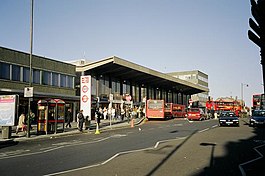
Limehouse is a National Rail and connected Docklands Light Railway (DLR) station in Limehouse, London, England. It is served by regional services operated by c2c to and from Fenchurch Street, and by light metro services provided by the DLR to and from Tower Gateway or Bank. On the main line, Limehouse is located 1 mile 58 chains (2.8 km) from Fenchurch Street and the following station is West Ham; on the DLR it is between Shadwell and Westferry in Travelcard Zone 2.

West Ham is a London Underground, Docklands Light Railway (DLR) and National Rail intermodal interchange station in West Ham, London, United Kingdom. The station is served by London Underground's District, Hammersmith & City and Jubilee lines, the Stratford International branch of the DLR, and c2c National Rail services.

Whitechapel is an interchange station in Whitechapel, East London for London Underground, London Overground and Elizabeth line services. The station is located behind a street market of the same name and opposite Tower Hamlets Town Hall. It lies between Aldgate East and Stepney Green stations on the District and Hammersmith & City lines, between Shoreditch High Street and Shadwell stations on the East London Line. To the West of Whitechapel on the Elizabeth Line is Liverpool Street, to the East the line splits with one branch going to Stratford and one to Canary Wharf. It is in Travelcard Zone 2.
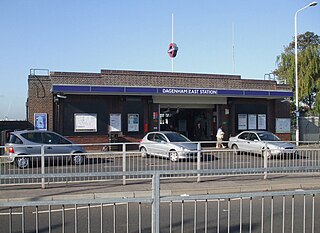
Dagenham East is a London Underground station located on the eastern side of the town of Dagenham in the London Borough of Barking and Dagenham, east London. It is on the District line between Dagenham Heathway to the west and Elm Park to the east. It is 6.4 kilometres (4.0 mi) along the line from the eastern terminus at Upminster and 27.8 kilometres (17.3 mi) to Earl's Court in central London where the line divides into numerous branches. The station has moderate usage for a suburban station, with approximately 3 million exits/entrances per year.
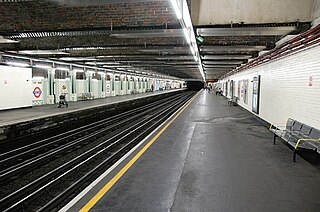
Stepney Green is a London Underground station located on Mile End Road in Stepney, London, United Kingdom. It is between Whitechapel and Mile End on the District line and the Hammersmith & City line, and is in Travelcard Zone 2.

Bow Road is a London Underground station located on Bow Road in Bow, London, England. It is on the District and Hammersmith & City lines. The station is interlinked as an out of station interchange (OSI) with Bow Church station on the Docklands Light Railway which is about 300 m (980 ft) away via Bow Road. The two stations are classed as a single station for ticketing purposes as well as on tube maps but both are managed separately.
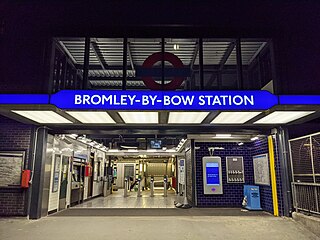
Bromley-by-Bow is a London Underground station located on the Blackwall Tunnel Northern Approach Road in the Bromley-by-Bow area of London, United Kingdom. The station is below the Blackwall Tunnel Northern Approach Road and lies between Bow Road and West Ham stations on the District and Hammersmith & City lines, and is in both Travelcard Zones 2 and 3.

Upton Park is a London Underground station on the District and Hammersmith and City lines, on Green Street in the Upton Park area of the London Borough of Newham, east London. It is in Zone 3.

Upminster is an interchange station serving the town of Upminster in the London Borough of Havering, Greater London. It is on the London, Tilbury and Southend line (LTSR), 15 miles 20 chains (24.5 km) down the line from London Fenchurch Street; it is the eastern terminus of the District line on the London Underground; and it is the eastern terminus of the Romford to Upminster Line on the London Overground network. Upminster is the easternmost station on the London Underground network as well as the easternmost National Rail station in London.

The London, Tilbury and Southend line, also known as Essex Thameside, is a commuter railway line on the British railway system. It connects Fenchurch Street station, in central London, with destinations in east London and Essex, including Barking, Upminster, Basildon, Grays, Tilbury, Southend and Shoeburyness.

Hornchurch is a London Underground station serving the town of Hornchurch in the London Borough of Havering, east London. It is on the District line between Elm Park to the west and Upminster Bridge to the east. It is 2.5 kilometres (1.6 mi) along the line from the eastern terminus at Upminster and 31.7 kilometres (19.7 mi) to Earl's Court in central London where the line divides into numerous branches.
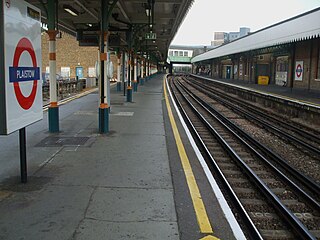
Plaistow is a London Underground station on Plaistow Road in the London Borough of Newham in Greater London. It is between West Ham and Upton Park stations on the District and Hammersmith & City lines, and in Travelcard Zone 3.

Becontree is a London Underground station located to the south of Becontree in the London Borough of Barking and Dagenham, east London. It is on the District line between Upney to the west and Dagenham Heathway to the east. It is 9.1 kilometres (5.7 mi) along the line from the eastern terminus at Upminster and 25.1 kilometres (15.6 mi) to Earl's Court in central London where the line divides into numerous branches. It is in Travelcard Zone 5.

Emerson Park is a London Overground station in the Emerson Park neighbourhood of Hornchurch in the London Borough of Havering, east London. The station is on the Romford–Upminster line and is the only intermediate station on that single-track line, located 1 mile 64 chains (2.9 km) from Romford and 1 mile 66 chains from Upminster. The station was opened in 1909 by the London, Tilbury and Southend Railway on a branch line which had connected Romford with Upminster and Grays since 1893. The station entrance is on Butts Green Road, with minimal station buildings other than a canopy over the single platform. Emerson Park is one of the least used stations in London and the least used London Overground station.

Romford railway station is an interchange station on the Great Eastern Main Line, serving the town of Romford in the London Borough of Havering, east London. It is 12 miles 30 chains (19.9 km) down the line from London Liverpool Street and is situated between Chadwell Heath and Gidea Park. It is also the northern terminus of a branch line to Upminster operated by London Overground. Its three-letter station code is RMF and it is in Travelcard Zone 6.
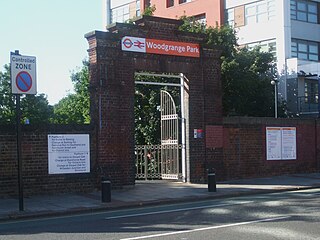
Woodgrange Park railway station is a railway station on Romford Road in Manor Park in the London Borough of Newham, east London. It is served by London Overground, and is on the Gospel Oak to Barking line, 12 miles 1 chain (19.3 km) down the line from Gospel Oak; it lies in Travelcard Zones 3 and 4. It has only limited station buildings and facilities.

Southend Central railway station is on the London, Tilbury and Southend line and is one of two primary stations serving the city of Southend-on-Sea, Essex. The city's other main station is called Southend Victoria which is the terminus of a branch line off the Great Eastern Main Line. Southend Central is 35 miles 55 chains (57.43 km) down the line from London Fenchurch Street via Basildon and it is situated between Westcliff and Southend East stations. Its three-letter station code is SOC.

The Romford–Upminster line is a railway branch line in Greater London that connects Romford, on the Great Eastern Main Line, to Upminster, on the London, Tilbury and Southend line and London Underground. The route is 3 miles 28 chains (5.4 km) in length and there is one intermediate station at Emerson Park which is located 1 mile 62 chains (2.9 km) from Romford. The line is part of Network Rail Strategic Route 7, SRS 07.09, and is classified as a rural line.
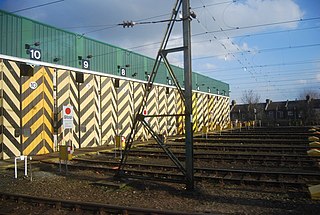
East Ham Depot is a depot on the London, Tilbury and Southend line between East Ham and Barking stations with the depot code EM. The depot is approximately 6+1⁄2 mi (10.5 km) from London Fenchurch Street station, and just west of the River Roding.

Southend East railway station is on the London, Tilbury and Southend line, serving the Southchurch area to the east of Southend-on-Sea, Essex. It is 36 miles 49 chains (58.9 km) down the main line from London Fenchurch Street via Basildon and it is situated between Southend Central to the west and Thorpe Bay to the east. Its three-letter station code is SOE.
